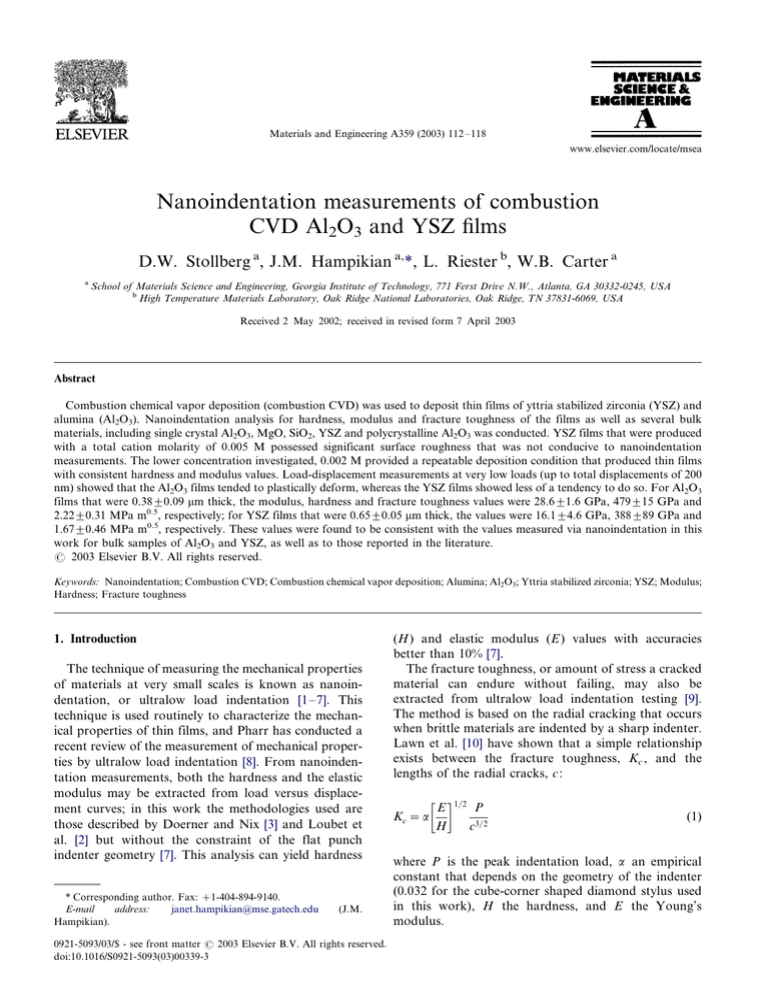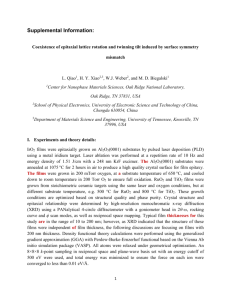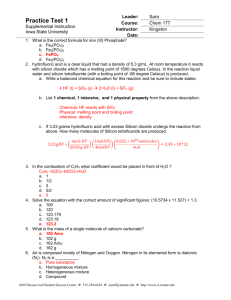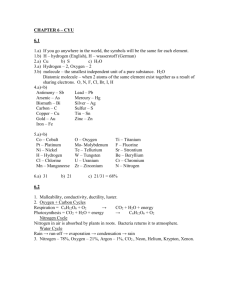
Materials and Engineering A359 (2003) 112 /118
www.elsevier.com/locate/msea
Nanoindentation measurements of combustion
CVD Al2O3 and YSZ films
D.W. Stollberg a, J.M. Hampikian a,*, L. Riester b, W.B. Carter a
a
School of Materials Science and Engineering, Georgia Institute of Technology, 771 Ferst Drive N.W., Atlanta, GA 30332-0245, USA
b
High Temperature Materials Laboratory, Oak Ridge National Laboratories, Oak Ridge, TN 37831-6069, USA
Received 2 May 2002; received in revised form 7 April 2003
Abstract
Combustion chemical vapor deposition (combustion CVD) was used to deposit thin films of yttria stabilized zirconia (YSZ) and
alumina (Al2O3). Nanoindentation analysis for hardness, modulus and fracture toughness of the films as well as several bulk
materials, including single crystal Al2O3, MgO, SiO2, YSZ and polycrystalline Al2O3 was conducted. YSZ films that were produced
with a total cation molarity of 0.005 M possessed significant surface roughness that was not conducive to nanoindentation
measurements. The lower concentration investigated, 0.002 M provided a repeatable deposition condition that produced thin films
with consistent hardness and modulus values. Load-displacement measurements at very low loads (up to total displacements of 200
nm) showed that the Al2O3 films tended to plastically deform, whereas the YSZ films showed less of a tendency to do so. For Al2O3
films that were 0.389/0.09 mm thick, the modulus, hardness and fracture toughness values were 28.69/1.6 GPa, 4799/15 GPa and
2.229/0.31 MPa m0.5, respectively; for YSZ films that were 0.659/0.05 mm thick, the values were 16.19/4.6 GPa, 3889/89 GPa and
1.679/0.46 MPa m0.5, respectively. These values were found to be consistent with the values measured via nanoindentation in this
work for bulk samples of Al2O3 and YSZ, as well as to those reported in the literature.
# 2003 Elsevier B.V. All rights reserved.
Keywords: Nanoindentation; Combustion CVD; Combustion chemical vapor deposition; Alumina; Al2O3; Yttria stabilized zirconia; YSZ; Modulus;
Hardness; Fracture toughness
1. Introduction
The technique of measuring the mechanical properties
of materials at very small scales is known as nanoindentation, or ultralow load indentation [1 /7]. This
technique is used routinely to characterize the mechanical properties of thin films, and Pharr has conducted a
recent review of the measurement of mechanical properties by ultralow load indentation [8]. From nanoindentation measurements, both the hardness and the elastic
modulus may be extracted from load versus displacement curves; in this work the methodologies used are
those described by Doerner and Nix [3] and Loubet et
al. [2] but without the constraint of the flat punch
indenter geometry [7]. This analysis can yield hardness
* Corresponding author. Fax: /1-404-894-9140.
E-mail
address:
janet.hampikian@mse.gatech.edu
Hampikian).
(J.M.
0921-5093/03/$ - see front matter # 2003 Elsevier B.V. All rights reserved.
doi:10.1016/S0921-5093(03)00339-3
(H) and elastic modulus (E ) values with accuracies
better than 10% [7].
The fracture toughness, or amount of stress a cracked
material can endure without failing, may also be
extracted from ultralow load indentation testing [9].
The method is based on the radial cracking that occurs
when brittle materials are indented by a sharp indenter.
Lawn et al. [10] have shown that a simple relationship
exists between the fracture toughness, Kc , and the
lengths of the radial cracks, c :
Kc a
1=2
E
P
H
c3=2
(1)
where P is the peak indentation load, a an empirical
constant that depends on the geometry of the indenter
(0.032 for the cube-corner shaped diamond stylus used
in this work), H the hardness, and E the Young’s
modulus.
D.W. Stollberg et al. / Materials and Engineering A359 (2003) 112 /118
The near-surface mechanical properties of hardness,
Young’s modulus and fracture toughness for thin films
of alumina (Al2O3) and yttria stabilized zirconia (YSZ)
that were deposited via combustion chemical vapor
deposition (combustion CVD) as well as bulk ceramics
were examined using nanoindentation. The bulk ceramics examined included single crystal Al2O3, polycrystalline Al2O3, YSZ (9.5 mol%Y2O3 /ZrO2), amorphous
silica and single crystal MgO. The objective of this
research was to compare the properties of the combustion CVD films grown on Al2O3 with bulk properties of
Al2O3 and YSZ, and to also evaluate the overall
suitability of nanoindentation to assess films with a
degree of surface inhomogeneity.
2. Experimental
The NanoIndenterTM II (Nano Instruments Inc.,
Knoxville TN, USA) [1,3] located at the High Temperature Materials Laboratory of Oak Ridge National
Laboratory in Oak Ridge, TN produced load versus
indentation depth plots, using the trigonal Berkovich
indenter with an initial tip radius of approximately 40
nm. The instrument was operated in the continuous
stiffness mode. For H and E measurements, an array of
15 indentations in a 5 /3 matrix with a 15 mm spacing
was selected. The samples were loaded to a total
displacement of approximately 200 nm, with hold
segments at 50 and 100 nm. For fracture toughness,
indentations were made at various loads, in a 5 /5
matrix consisting of five indentations each at 400, 250,
100, 50 and 25 mN of load. The average crack length
was determined from the three cracks formed from each
of the twenty-five indents made. The experimental
uncertainty in the data is the standard deviation of the
calculated fracture toughness. In accordance with the
expression developed by Lawn et al. [10] not all cracks
formed by an indent were used; only well-developed
radial cracks (lateral cracks and cracks shorter than
approximately two times the indent size were excluded).
A Hitachi S-800 scanning electron microscope was used
to measure crack lengths.
The bulk ceramic specimens that were tested are listed
in Table 1. The single crystal alumina, MgO, silica and
YSZ samples were 99.99% pure while the polycrystalline
Al2O3 had a 99.6% purity level. All specimens were 0.5
mm thick except the YSZ which was 1 mm thick. All
bulk specimens were 1 cm by 1 cm in area and polished
by the manufacturer to a roughness of less than 2 nm Rq
rms. Each sample was ultrasonically cleaned in acetone
followed by an isopropanol rinse prior to nanoindentation.
The thin film samples of Al2O3 and 4.5 mol% YSZ
were prepared via liquid-fuel combustion CVD, using
toluene as fuel and precursor solvent, and yttrium and
113
zirconium 2-ethylhexanoate as precursors for YSZ films,
with aluminum acetylacetonate as the precursor for
Al2O3 films. The substrate in both cases was a-plane
Al2O3, and the deposition temperature 1550 8C. Details
on the synthesis process conditions are provided elsewhere; in brief, the deposition technique involves burning the precursor-containing fuel in the open
atmosphere, and depositing films on substrates positioned in or near the flame [11,12].
3. Results and discussion
YSZ samples were deposited with two different total
cation molarities, 0.002 and 0.005 M, and characterized
by plan view SEM, see Fig. 1a/b. Surface topography is
strongly affected by solution precursor concentration,
with smoother films observed at the lower concentration. Nanoindentation experiments that were conducted
for both concentrations of YSZ material showed a large
discrepancy between their load /displacement curves.
The higher concentration samples displayed poor load /
displacement curves in that after discounting the highest
and lowest maximum loads, the maximum load to cause
200 nm of displacement varied between approximately
0.35 nm and 1.5 mN, corresponding to unrealistic values
of hardness and modulus compared with bulk properties
for this material. By contrast, the lower concentration
samples required in excess of 8 mN of load for 12 of the
15 nanoindentations; and for these load displacement
curves, the average maximum load at 200 nm displacement was 15 mN, with the average of the other three
curves being only 0.7 mN. It was concluded that the
surface roughness of the higher concentration samples
was prohibitive to conducting meaningful nanoindentation work, and thus nanoindentation results from only
the 0.002 M samples are presented below. Even at the
lower concentration, it was necessary to scrutinize each
load displacement curve, as the films produced by
combustion CVD still had sufficient surface asperities
as to cause approximately 20% of the load displacement
curves to be erroneously low. Finally, as the film quality
was higher for YSZ grown at 0.002 M, the Al2O3 films
investigated in this work were grown from a precursor
concentration of 0.002 M only.
Plan view and cross-sectional SEM images of Al2O3
and YSZ deposited with 0.002 M precursor solutions are
shown in Fig. 1. In both cases, thin films of Al2O3 and
YSZ samples are produced, with thicknesses corresponding to 0.389/0.09 and 0.659/0.05 mm, respectively.
The Al2O3 film is difficult to discern in cross-section in
Fig. 1c, as the phase deposited is a-Al2O3, the same as
the substrate. X-ray diffraction of the Al2O3-coated
substrate (not shown) does not reveal the presence of
any extra peaks from the Al2O3 coating (peaks from the
Al2O3 substrate only were present), consistent with the
114
D.W. Stollberg et al. / Materials and Engineering A359 (2003) 112 /118
Table 1
Mechanical properties of substrates and films, values obtained in this work compared with values obtained from literature
Material
Al2O3
SiO2
MgO
YSZ (9.5mol% Y2O3)
YSZ Film
Al2O3 Film
Hardness (GPa)
Elastic Modulus (GPa)
Fracture Toughness MPa m0.5
This Work
Literature
This Work
Literature
This Work
Literature
30.99/1.23
8.79/0.3
8.49/1.7
199/0.2
16.19/4.6
28.69/1.6
25 [9]
8.3 [1]
7 [23]
13 [5]
4819/16
72.29/1.6
2909/38
3099/6
3889/89
4799/15
433 [1]
72.4 [22]
300 [16]
200 [5]
2.39/0.6
0.709/0.17
1.29/0.2
1.309/0.29
1.679/0.46
2.229/0.31
2.2 [15]
0.58 [1]
1.77 [24]
2.8 [17]
smoothness of the Al2O3 films as compared with the
YSZ films that were deposited, see Fig. 1c /f. A feature
that was commonly noted on the Al2O3 films, see Fig. 2,
was the presence of ‘‘pop-ins,’’ displacement discontinuities in the load /displacement response due to
plasticity [13]. These features are commonly exhibited
on hard, stiff materials such as Al2O3; of note is the
absence of significant pop-ins on the uncoated Al2O3.
As an artifact of the loading sequence, pop-ins were
commonly seen immediately prior to the 50 and 100 nm
hold segments, as seen in Fig. 2. They were also
observed at other displacements. It should be noted
that during the constant load hold segment corresponding to approximately 50 nm displacement, a very slow
time-dependent strain rate was observed, 0.5% of the
total penetration for the 16 s hold segment. The average
load required for 50 nm displacement is 2.29/0.3 mN,
which correlates approximately to a loading rate of /
0.14 mN s 1. Krell et al. [14] have also observed kinetic
effects associated with their measurements on sub-mm
polycrystalline Al2O3. In their work, nanoindentation
experiments with loading to 200 mN on polycrystalline
Al2O3 showed 0.3 /2% of the total penetration within 5 s
after loading with 4.4 mN s 1 and less than 0.5% within
30 s after slow loading with 0.44 mN s 1.
3.1. Hardness and elastic modulus
Fig. 1. Scanning electron microscope images of films deposited via
combustion CVD: (a) plan view image obtained from 0.002 M total
cation precursor concentration; (b) plan view image from 0.005 M
concentration; (c /d) plan view and cross-section from 0.002 M Al2O3
film, (e /f) plan view and cross-section from 0.002 M YSZ film.
formation of the a-Al2O3 phase. The presence of some
surface roughness even at this lower concentration is
noted, see for example Fig. 1f.
Representative load /displacement curves (P /d) for
the 0.002 M Al2O3 and YSZ coatings, as compared with
a-plane Al2O3 substrate are shown in Fig. 2. Unlike the
YSZ films, all 15 of the load-displacement curves for
Al2O3 showed consistent load displacement curves with
loads that ranged between approximately 22 to 24 mN
at 200 nm displacement. This is likely due to the relative
Fig. 3a shows the results of the hardness analysis
versus the indentation depth for the materials tested. In
total, the a-plane Al2O3 was tested six times, inserted at
a lightly different ‘‘rotation’’ each time; the highest and
lowest values obtained are shown in Fig. 3a. For clarity,
the other four plots are not shown. The hardness of
polycrystalline alumina and r-plane alumina, which
were tested for comparison purposes, fell approximately
within the range of the a-plane Al2O3 data, see Fig. 3a.
The average hardness values for a-plane Al2O3 are
presented in Table 1. Polycrystalline Al2O3 and r-plane
Al2O3 were tested for comparison purposes, see Fig. 3.
The hardness values for combustion CVD coatings of
Al2O3 and YSZ were also evaluated; these results are
presented in Fig. 3a and in Table 1. It is seen that the
D.W. Stollberg et al. / Materials and Engineering A359 (2003) 112 /118
115
Fig. 2. Load (mN) vs. displacement (nm) curves obtained from a-plane Al2O3, Al2O3 film and YSZ film. Note presence of ‘‘pop-ins’’ for Al2O3 film
curves.
alumina coating has hardness values that lie slightly
below that of the bulk material.
The hardness values for the combustion CVD-deposited YSZ coating, bulk YSZ, MgO and silica are also
shown in Fig. 3a and also summarized in Table 1. The
hardness values for MgO and silica are approximately
the same; bulk YSZ has an average hardness value that
is between that of alumina and silica/MgO, as expected
Fig. 3. Hardness (a) and elastic modulus (b) plotted as a function of indentation depth for the Al2O3 and YSZ films as well as bulk materials
including r-plane, a-plane and polycrystalline Al2O3, bulk ZrO2 (YSZ), SiO2 and MgO.
D.W. Stollberg et al. / Materials and Engineering A359 (2003) 112 /118
116
from literature values [1,5,9,23]. The hardness values for
YSZ coatings are seen to be consistent with the values
seen for bulk YSZ, see Fig. 3a. The YSZ films hardness
values have error bars that are quite large, due to the
large variation in load /displacement that is present with
the combustion CVD deposited film. This is likely due
to the surface roughness present on these films, although
the coating may also not be fully dense.
Since combustion CVD is an open air deposition
process, with numerous variables in play at one time in
deposition (e.g. nozzle conditions, oxidant flow rate,
fuel flow rate, temperature, etc.), there was some
concern about the repeatability of the process to yield
films of similar properties. Therefore, five different films
of YSZ were deposited on separate days and subsequently tested. Scanning electron microscopy of the
surfaces of the films showed some differences in the
surface topography for the materials, for example, see
Fig. 1a /e. However, the hardness and elastic modulus
values from the five YSZ coatings were found to be
statistically the same, using the t-test, see Table 2. The
error bars for each of the five different depositions are
based on the different values obtained from each of the
fifteen indents for that specimen, and are quite large
relative to the substrates.
The elastic moduli for the six orientations of a-plane
Al2O3, the r-plane Al2O3 and the polycrystalline Al2O3
are not statistically different, see Fig. 3b. The average
modulus for the six orientations of a-plane alumina was
found to be 4819/16. The YSZ and MgO elastic moduli
were approximately the same, with the value for bulk
silica being somewhat lower, as summarized in Table 1.
The modulus for the combustion CVD YSZ film had
slightly higher values, but within experimental uncertainty of the bulk YSZ measurements, except at the
highest load. The 200 nm displacement corresponds to
approximately one third the YSZ film thickness (6509/
50 nm), and thus the higher modulus seen at this load
might be slightly influenced by the substrate.
The hardness and elastic bulk modulus values measured via nanoindentation were close to their bulk
material literature values, obtained from large scale
testing as summarized in Table 2. For bulk hardness
measurements, Vickers, Knoop, Brinell or Rockwell
testing equipment was used, and for bulk elastic
Table 2
Repeatability of nanoindentation results for five 100% YSZ films
deposited via combustion CVD on different occasions
Sample
H (MPa)
E (GPa)
Kc (MPa m0.5)
1
2
3
4
5
15.29/2.5
15.89/1.4
15.19/2.3
15.39/1.8
13.89/5.0
3209/43
3409/35
3469/56
3289/38
3009/101
1.599/0.48
1.939/0.48
1.959/0.31
1.569/0.31
1.739/0.48
modulus values, tensile tests or three point bend tests
were used [15 /17]. Results from other researchers
performing nanoindentation on similar ceramics also
agree with these hardness and elastic modulus values.
For example, Oliver and Pharr [7] used a Berkovich
indenter producing results on sapphire of /30 GPa for
hardness and 450 GPa for elastic modulus and for silica,
9 /10 GPa for hardness and 70 /80 GPa for the elastic
modulus. Boudoukha et al. [18] found hardnesses and
elastic moduli in similar ranges as those reported here
for polycrystalline alumina: hardness 20/40 GPa and
elastic modulus 300 /500 GPa. For sapphire their results
were somewhat higher: hardness 40/50 GPa and elastic
modulus 500 /600 GPa. Using a Vickers indenter tip,
Krell and Schadlich [14] measured the hardness of
polycrystalline alumina and single-crystal sapphire to
be 25/30 GPa. Yttria-stabilized zirconia was measured
by Voevodin et al. [19] as 25 GPa for the hardness and
300 GPa for the elastic modulus, also agreeing with the
results in this report.
3.2. Fracture toughness
The results of the fracture toughness testing are
shown in Table 1 and Fig. 4. All of the a-plane
substrates produced very similar toughness values, /
2.3 MPa m0.5, within one standard deviation of each
other, regardless of the orientation of the indenter. The
r-plane Al2O3 had a significantly higher measured
toughness than a-plane and polycrystalline Al2O3, 3.2
versus 2.3 MPa m0.5. The alumina film grown by
combustion CVD had comparable fracture toughness
values to bulk values, at 2.2 MPa m0.5. The error bars
associated with fracture toughness, shown in Fig. 4, are
based on uncertainty in crack length used to calculate
fracture toughness (Eq. (1)). The YSZ film grown by
combustion CVD also showed fracture toughness values
that are comparable to values measured by nanoindentation on bulk YSZ in this work.
Table 1 shows a comparison of the nanoindentation
fracture toughness values for bulk materials (Al2O3,
SiO2, MgO, YSZ) measured in this work to the fracture
toughness from bulk materials from the literature. The
nanoindentation results for bulk materials in this work
are similar to the toughness values obtained by larger
scale testing. All of the ceramics produced toughness
values with experimental uncertainties on the order of 9/
0.5 MPa m0.5, that were similar to fracture toughness
values reported in the literature [9,20,21]. Silica’s
nanoindentation fracture toughness, 0.70 MPa m0.5,
was higher than the bulk value of 0.58 MPa m0.5. By
contrast, the toughness for MgO was significantly lower
for nanoindentation, 1.2 MPa m0.5, compared with the
bulk value, 1.77 MPa m0.5. Similarly for bulk YSZ, the
fracture toughness obtained via nanoindentation was
1.3 MPa m0.5 compared with reported literature value of
D.W. Stollberg et al. / Materials and Engineering A359 (2003) 112 /118
117
Fig. 4. Fracture toughness values obtained from this work for a-plane, r-plane, polycrystalline Al2O3, Al2O3 film, YSZ, YSZ film, MgO and SiO2.
2.8 MPa m0.5. The variations in fracture toughness
measured via nanoindentation compared with fracture
toughness reported in the literature are likely due to
differences in the near surface regions of the material.
For example, a surface with compressive residual stress
would act to close cracks and result in higher fracture
toughness (silica), whereas residual tensile stress in the
surface would result in lower fracture toughness (YSZ
and MgO).
4. Summary and conclusions
Combustion-CVD thin films that are deposited at a
precursor concentration of 0.002 M grow smoother
films that are better suited for nanoindentation measurements than films grown at the higher concentration
of 0.005 M. Repeatability tests on five different combustion CVD-deposited thin films show consistent values of
hardness and modulus, although larger error bars are
associated with combustion CVD film properties as
compared with those found from bulk materials. Al2O3
films exhibited significant plastic deformation (pop-ins)
in comparison with the YSZ films that were deposited.
For Al2O3 films that were 0.389/0.09 mm thick, the
modulus, hardness and fracture toughness values were
28.69/1.6 GPa, 4799/15 GPa and 2.229/0.31 MPa m0.5,
respectively; for YSZ films that were 0.659/0.05 mm
thick, the values were 16.19/4.6 GPa, 3889/89 GPa and
1.679/0.46 MPa m0.5, respectively. These values are
consistent with the values measured via nanoindentation
in this work for bulk samples of Al2O3 and YSZ, as well
as to those reported in the literature.
Acknowledgements
This material is based upon work supported by the
National Science Foundation under Grant No DMR9624927. The nanoindentation work was research sponsored by the Assistant Secretary for Energy Efficiency
and Renewable Energy, Office of Transportation Technologies, as part of the High Temperature Materials
Laboratory User Program, Oak Ridge National Laboratory, managed by Lockheed Martin Energy Research Corp. for the US Department of Energy under
contract number DE-AC05-96OR22464. This research
was conducted with the support of the US Department
of Energy, under Cooperative Agreement No. DEFC21-92MC29061. However, any opinions, findings,
conclusions, or recommendations expressed herein are
those of the authors and do not necessarily reflect the
views of the DOE.
References
[1] J.B. Pethica, R. Hutchings, W.C. Oliver, Phil. Mag. A48 (1983)
593.
[2] J.L. Loubet, J.M. Georges, J.M. Marchesini, G. Meille, J. Tribol.
106 (1984) 43 /48.
[3] M.F. Doerner, W.D. Nix, J. Mater. Res. 1 (4) (1986) 601 /609.
[4] W.C. Oliver, Mater. Res. Soc. Bull. 11 (1986) 15 /19.
[5] W.D. Nix, Metall. Trans. 20A (11) (1989) 2217 /2245.
[6] G.M. Pharr, W.C. Oliver, Mater. Res. Soc. Bull. 17 (1992) 28.
[7] W.C. Oliver, G.M. Pharr, J. Mater. Res. 7 (6) (1992) 1564 /1583.
[8] G.M. Pharr, Mat. Sci. Eng. A 253 (1998) 151 /159.
[9] D.S. Harding, W.C. Oliver, G.M. Pharr, Mater. Res. Soc. Symp.
Proc. Thin Films: Stresses Mech. Prop. V 356 (1995) 663 /668.
[10] B.R. Lawn, A.G. Evans, D.B. Marshall, J. Am. Ceram. Soc. 63
(1980) 574.
[11] J.M. Hampikian, W.B. Carter, Mat. Sci. Eng. A 267 (1999) 7.
[12] D. Stollberg, W.B. Carter, J.M. Hampikian, et al. Paper Two.
118
D.W. Stollberg et al. / Materials and Engineering A359 (2003) 112 /118
[13] T.F. Page, W.C. Oliver, C.J. McHargue, J. Mater. Res. 7 (2)
(1992) 450 /473.
[14] A. Krell, S. Schadlich, Mater. Sci. Eng. A 307 (2001) 172 /181.
[15] G.M. Pharr, D.S. Harding, W.C. Oliver, Mechanical Properties
and Deformation Behavior of Materials Having Ultra-Fine
Microstructures, in: M. Nastasi, D.M. Parkin, H. Gleiter,
(Eds.), NATO ASI Series, Series E: Applied Sciences, vol 233,
1993, pp 449 /462.
[16] Matroc, Morgan Advanced Ceramics, 582 Monastery Dr, Latrobe, PA 15650.
[17] Guide to Engineered Materials, Advanced Materials & Processes,
vol 156, sixth ed., in: M.W. Hunt (Ed.), Materials Park, OH,
1999, p. 143.
[18] L. Boudoukha, F. Halitim, S. Paletto, G. Fantozzi, Ceram. Int. 24
(1998) 189 /198.
[19] A.A. Voevodin, J.J. Hu, J.G. Jones, T.A. Fitz, J.S. Zabinski, Thin
Solid Films 401 (2001) 187 /195.
[20] A.G. Evans, A.H. Heuer, D.L. Porter, Fracture, I (TCF4),
Waterloo, Canada, June 19 /24, 1977, pp 529 /556.
[21] N. Claussen, J. Steeb, R.F. Pabst, Am. Ceram. Soc. Bull. 56 (6)
(1977) 559 /562.
[22] W.D. Kingery, H.K. Bowcn, D.R. Uhlmann, Introduction to
Ceramics, Wiley, New York, NY, 1976.
[23] Atlantic Equipment Engineers, 13 Foster St. Bergenfield, NJ,
07621.
[24] D.G. Isaak, O.L. Anderson, T. Goto, Phys. Chem. Miner. 16
(1989) 704 /713.







